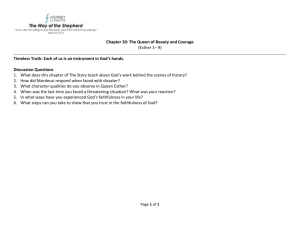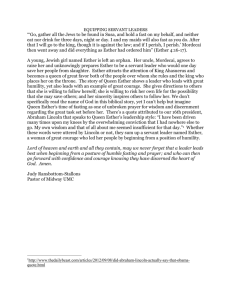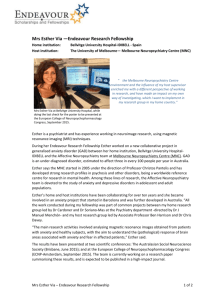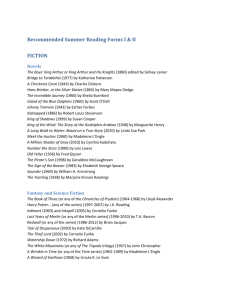Artistic Depiction of Megillat Esther
advertisement
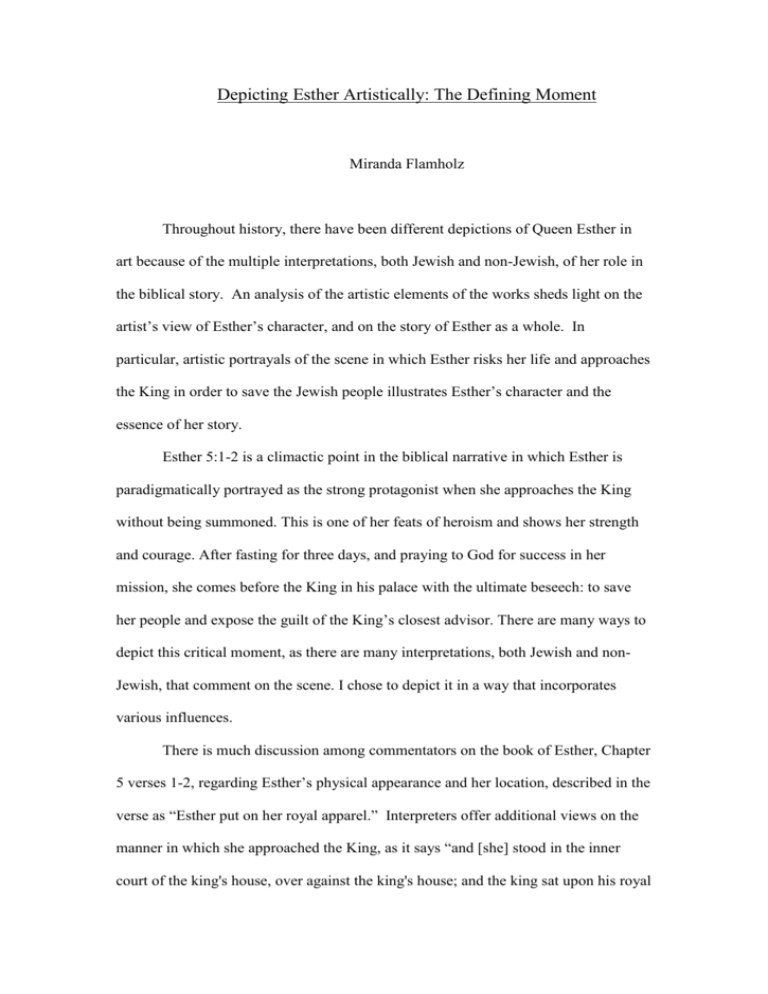
Depicting Esther Artistically: The Defining Moment Miranda Flamholz Throughout history, there have been different depictions of Queen Esther in art because of the multiple interpretations, both Jewish and non-Jewish, of her role in the biblical story. An analysis of the artistic elements of the works sheds light on the artist’s view of Esther’s character, and on the story of Esther as a whole. In particular, artistic portrayals of the scene in which Esther risks her life and approaches the King in order to save the Jewish people illustrates Esther’s character and the essence of her story. Esther 5:1-2 is a climactic point in the biblical narrative in which Esther is paradigmatically portrayed as the strong protagonist when she approaches the King without being summoned. This is one of her feats of heroism and shows her strength and courage. After fasting for three days, and praying to God for success in her mission, she comes before the King in his palace with the ultimate beseech: to save her people and expose the guilt of the King’s closest advisor. There are many ways to depict this critical moment, as there are many interpretations, both Jewish and nonJewish, that comment on the scene. I chose to depict it in a way that incorporates various influences. There is much discussion among commentators on the book of Esther, Chapter 5 verses 1-2, regarding Esther’s physical appearance and her location, described in the verse as “Esther put on her royal apparel.” Interpreters offer additional views on the manner in which she approached the King, as it says “and [she] stood in the inner court of the king's house, over against the king's house; and the king sat upon his royal throne in the royal house, over against the entrance of the house.” Various opinions also emerge regarding the King’s reaction to her request. As it says, “when the king saw Esther the queen standing in the court, she obtained favor in his sight; and the king held out to Esther the golden scepter that was in his hand. So Esther drew near, and touched the top of the scepter.” These three aspects of the encounter must be analyzed in order to get a full sense of the scene and its significance. M’nos Halevi notes that Esther dressed in “royalty” because Mordecai had stressed the importance of the mission to save the Jews and she wanted to make a good impression even though she had previously refrained from wearing such garments as Queen.1 iThe Midrash Rabbah further explains the nature of these royal garments and says that Esther was dressed in adi teferes, which either refers to a glorious headdress or a cloak, with a golden hemmed long train attached. She had two maidservants with her and she placed her right hand on one for support, as was the royal custom. The second carried her train. She appeared happy in an attempt to hide the anxiety in her heart.2 Other commentaries interpret the “royalty” to have a metaphorical rather than a literal meaning. Malbim interprets the statement that Esther was “robed in majesty” to mean that she had an aura of majesty such that all who saw her recognized that she was ideally suited to be queen.3 There also could have been a spiritual connotation to this phrase. Some of our Sages explain that the verse was not referring to Esther’s 1 Referenced in Zlotowitz, Rabbi Meir. The Book of Esther/A New Translation With a Commentary Anthologized from Talmudic, Midrashic, and Rabbinic Sources. New York: Mesorah Publications Ltd., 1976. 83 2 Feldheim Publishers, The Midrash Rabbah/Complete Vowelized Midrash Text. Jerusalem: Machon HaMidrah HaMevo'ar, 2002. 9:1 3 Translated and Annotated by Jonothan Taub. The Malbim Esther. Southfield: Targum Press, 1998. 102-103 royal clothing but rather that she had ruach hakodesh, or divine spirit, that accompanied her.4 Similarly, Rabbi David Feinstein notes that it was the first night of Passover, the “Night of protections,” and therefore, she had extra divine spirit with her, which is what gave her the courage to confront the King.5 When Esther entered the palace the word vataamod, literally meaning “and she stood,” is interpreted by the M'nos Halevi to mean that she was praying.6 The Midrash elaborates that when Esther entered the King’s chamber of idols she lost the divine spirit, so she prayed and said, “My God, my God, why hast Thou forsaken me?”7 In the midrashic expansion, Esther encountered obstacles on her way to the King and she had to pass through seven departments in the palace. The courtiers hoped that she would be executed like Vashti and that they would be able to apportion her clothing and jewelry among themselves; those close to Ahasuerus encircled her and harassed her on her way to the King, while Haman’s sons awaited her downfall. After she came to the fourth department, Ahasuerus’ ire was aroused and he remembered Vashti, who did not come to him despite his repeated requests, while Esther came to him without permission. Esther stood in the middle of the fourth department; the guards of the first department could no longer touch her, while those of the last department could not yet approach her. Ahasuerus’ close advisors attempted sorcery, so that her hands and feet would look like leather hides, but a miracle was performed for her and her feet began to shine like sapphires.8 In Talmud Megilla, the Rabbis interpret that Esther was so worn out and tired after her three day fast that she was in no position to get to the King’s palace, let alone 4 Weinbach, Mendel. 127 insights into Megillas Esther. Southfield: Targum Press, 1990. 117 5 Walfish, 34-35 6 Zlotowitz, 83 7 Also found in Psalms 22:2 8 Midrash Tehilim, on Psalms. 22:7, 24–26 make a request of him. Therefore, God sent her with three angels to help her. One raised her head erect and one endowed her with miraculous charm. When the golden scepter was extended toward Esther, she would have to touch it in order to accept the King’s offering and make her request, but she was too far away to do so. Therefore, the third angel was sent to extend the scepter so that it touched Esther’s fingertips.9 Other commentaries focus on the King’s reaction to Esther’s intrusion and what ensues thereafter. The Malbim interprets Ahasuerus’ gesture as a sign that the King loved Esther so much that it never occurred to him that the decree that prohibited people from entering his inner court without permission applied to her.10 Therefore, when he saw her standing humbly in the court waiting for permission, she found favor in his eyes and he extended his golden scepter. However, Midrash Rabbah explains that when Ahasuerus saw Esther standing before him, his wrath burned inside of him because she violated the law. When Esther saw him his eyes were burning like fire, and she became very frightened and her spirit became faint. She was so weak that she put her head on her maidservant’s shoulder. God saw this and took pity on the Jews and granted Esther favor in the eyes of the King. Then, not only did the King extend the scepter, but ran to her side. He hugged and kissed her and said “Queen Esther! Why be afraid of me? That law we enacted does not apply to you…”11 The Midrash in Panim Aherim follows the theme of angels and the inclusion of the godly presence and suggests that when Esther entered the palace, Ahasuerus first tried to turn his face so that he would not look upon her, but the ministering 9 Weinbach, 117 10 Taub, 103-104 11 Midrash Rabbah, 9:1 angels forcibly turned his head, until he cried out. He was blinded, but when he looked in her direction his vision was restored and he extended his scepter.12 In my own artistic portrayal of Esther, I took into account many other paintings that depicted this scene. Looking at various paintings from different time periods, I noticed some qualities about the scene that these paintings shared. Many paintings, including Poussin’s ‘Esther Before Ahasuerus’, depict Esther fainting and leaning on the arm of her maidservant.13 This idea likely came from the Apocryphal additions to the original scriptures based on the Septuagint.14 However, it is also present in one of the Jewish interpretations in Midrash Rabbah. Such a portrayal of Esther is likely used to express the nerves in Esther’s heart, and her uneasiness approaching the King without being called, as well as the fact that she had been fasting for the last three days before entering the palace. The Jewish interpretation, however, usually depicts Esther as a strong, powerful woman. 12 Midrash Panim Aherim, version B, para. 5 13 Nicolas Poussin. Esther Before Ahasuerus. 1655. Hermitage, St. Petersburg. 14 Can be seen in the Revised Standard Version Catholic Edition of the Bible, addition 15 'Esther Before Ahasuerus' by Pompeo Batoni,15 as well as other paintings, depict lions surrounding the King’s throne or adorning his palace, some of which are winged creatures. There is a biblical source for such creatures described in the book of Daniel, as one of the four kings that will “arise out of the earth” and rule over the Jewish people.16 The lion creature is known to be the Babylonian Empire while the next creature, a bear with ribs in its mouth, is said to represent Persia.17 Similar creatures are also included in Persian mythology and have come to symbolize the king of all creatures. Sculptures of similar creatures have been found in the remains of Persian Palaces, mainly of Darius I. Many of the paintings depict maidservants accompanying Esther. This was the custom in many ancient kingdoms, and therefore is manifested in the artwork portraying that time. The common etiquette was for the queen to have maidservants accompanying her at all times. We are introduced to these maidservants earlier in the 15 Pompeo Batoni, Esther Before Ahasuerus. 1738-40. Philadelphia Museum of Art, Philadelphia 16 Daniel Chapter 7 17 Rashi Daniel 7:5 story.18 The Midrash picks up on this custom and includes the maidservants in the story of Esther approaching the King as well.19 In light of such influences, in my own vision of this tale, I depicted Esther standing before the king, tired and worn out from fasting, yet dressed in her beautiful clothing with a long train lined with gold. This can be seen through the interpretations and sources cited above. As part of her elaborate adornments, Esther’s crown is lined with Hebrew letters, spelling out parts of the phrase ““ “ ’’אלי אלי למה עזבתניMy God, my God, why hast Thou forsaken me?” which is said to be the phrase that she was saying as she prayed. This shows that she is constantly focused on the words of God, and his protection, even in times when she fears that she has lost the divine spirit. Esther is standing on the fourth out of seven steps to the throne, corresponding to the Midrash Tehillim which explains that Esther was in the fourth out of seven chambers of the palace when she approached Ahasuerus’ throne. This also represents the idea noted in the Zohar that as Esther was walking through the palace she was ascending in the “sfirot” of prayer.20 Additionally, I depicted three women helping her. These women represent the maidservants that accompanied her and assisted her, as they can be seen guiding her and holding her train, as was the custom in Persian culture.21 However, they also represent the three angels that God sent with her to bestow her with charm, and extend the King's scepter to touch her hand.22 18 Esther 2:9 19 Midrash Rabbah, 9:1 20 Walfish, Barry Dov. Esther in Medieval Garb/Jewish Interpretation of the Book of Esther in the Middle Ages. Albany: State University of New York Press, 1993. 36-37 21 Midrash Rabbah, 9:1 22 Weinbach, 117 After researching numerous interpretations of the scene of Esther approaching King Ahasuerus, as well as the ways in which several artists depicted this dramatic point in the narrative, I gained many insights into Esther's character the Megilla in its entirety. I used biblical and Midrashic commentaries and diverse artists' unique interpretative styles as inspiration for my own artwork. My depiction represents the way I have come to view Esther’s role in this climactic scene and illustrates aspects that are not explicit in the text, yet contribute to a richer understanding of the story.
